Opportunities, Quality Factors, and Required Changes during the Pandemic Based on Higher Education Leaders’ Perspective
Abstract
:1. Introduction and Background
2. Research Design and Methodology
3. Research Results
3.1. Required Key Changes for Organizations and Learning Processes
3.1.1. Transformed Studies
3.1.2. Remote Self-Directed Learners
3.2. Opportunities Existing in Each Organization to Ensure a Successful Study Process
3.2.1. New Study Forms
3.2.2. Strengthen Distance Learning
3.2.3. Offering Services
3.2.4. Limitations of Distance Learning
3.3. Quality Factors Are Identified for the Successful Implementation of Distance Learning during the Pandemic Period
3.3.1. Administrative Actions
3.3.2. Collaboration of Academic Community
3.3.3. Support for Academics
3.3.4. Support for Students
3.3.5. Technical Base
3.3.6. Study Process Control
4. Conclusions and Discussion
Author Contributions
Funding
Institutional Review Board Statement
Informed Consent Statement
Data Availability Statement
Conflicts of Interest
References
- Burgess, S.; Sievertsen, H.H. Schools, Skills, And Learning: The Impact of COVID-19 on Education. 2020. Available online: https://voxeu.org/article/impact-covid-19-education (accessed on 30 December 2020).
- Chen, Y.; Hou, A.Y.C.; Huang, L. Development of distance education in Chinese higher education in perspectives of accessibility, quality and equity under COVID-19. Asian Educ. Dev. Stud. 2021. ahead-of-print. [Google Scholar] [CrossRef]
- Quadir, B.; Zhou, M.H. Students perceptions, system characteristics and online learning during the COVID-19 epidemic school disruption. Int. J. Distance Educ. Technol. 2021, 19, 1–19. [Google Scholar] [CrossRef]
- Chen, C.M.; Li, M.C.; Chang, W.C.; Chen, X.X. Developing a topic analysis instant feedback system to facilitate asynchronous online discussion effectiveness. Comput. Educ. 2020, 163, 104095. [Google Scholar] [CrossRef]
- El Firdoussi, S.; Lachgar, M.; Kabaili, H.; Rochdi, A.; Goujdami, D.; El Firdoussi, L. Assessing distance learning in higher education during the COVID-19 pandemic. Educ. Res. Int. 2020, 2020, 8890633. [Google Scholar] [CrossRef]
- Hilton, R.; Moos, C.; Barnes, C. A Comparative Analysis of Students’ Perceptions of Learning in Online versus Traditional Courses. E-J. Bus. Educ. Scholarsh. Teach. 2020, 14, 2–11. Available online: https://files.eric.ed.gov/fulltext/EJ1292855.pdf (accessed on 30 December 2020).
- Mseleku, Z. A literature review of e-learning and e-teaching in the era of COVID-19 pandemic. J. Innov. Sci. Res. Technol. 2020, 5, 588–597. [Google Scholar]
- Trespalacios, J.; Snelson, C.; Lowenthal, P.; Uribe-Flórez, L.; Perkins, R. Community and connectedness in online higher education: A scoping review of the literature. Distance Educ. 2020, 42, 5–21. [Google Scholar] [CrossRef]
- Rajkumar, R.P. COVID-19 and mental health: A review of the existing literature. Asian J. Psychiatry 2020, 52, 102066. [Google Scholar] [CrossRef]
- Rossi, R.; Socci, V.; Talevi, D.; Mensi, S.; Niolu, C.; Pacitti, F.; Di Lorenzo, G. COVID-19 pandemic and lockdown measures impact on mental health among the general population in Italy. Front. Psychiatry 2020, 11, 1–6. [Google Scholar] [CrossRef]
- Tandon, R. COVID-19 and mental health: Preserving humanity, maintaining sanity, and promoting health. Asian J. Psychiatry 2020, 51, 102256. [Google Scholar] [CrossRef]
- Chen, T.; Peng, L.; Yin, Y.; Rong, J.; Yang, J.; Cong, G. Analysis of user satisfaction with online education platforms in China during the COVID-19 pandemic. Healthcare 2020, 8, 200. [Google Scholar] [CrossRef] [PubMed]
- Goh, P.S.; Sandars, J. Rethinking scholarship in medical education during the era of the COVID-19 pandemic. Med. Ed. Publ. 2020, 9, 1–14. [Google Scholar] [CrossRef]
- Teräs, M.; Suoranta, J.; Teräs, H.; Curcher, M. Post-COVID-19 education and education technology “solutionism”: A seller’s market. Postdigit. Sci. Educ. 2020, 2, 863–878. [Google Scholar] [CrossRef]
- Costa, L.A.; Pereira Sanches, L.M.; Rocha Amorim, R.J.; do Nascimento Salvador, L.; dos Santos Souza, M.V. Monitoring academic performance based on learning analytics and ontology: A systematic review. Inform. Educ. 2020, 19, 361–397. [Google Scholar] [CrossRef]
- Sahu, P. Closure of universities due to coronavirus disease 2019 (COVID-19): Impact on education and mental health of students and academic staff. Cureus 2020, 12, e7541. [Google Scholar] [CrossRef] [Green Version]
- Crawford, J.; Butler-Henderson, K.; Rudolph, J.; Malkawi, B.; Glowatz, M.; Burton, R.; Magni, P.; Lam, S. COVID-19: 20 countries’ higher education intra-period digital pedagogy responses. J. Appl. Learn. Teach. 2020, 3, 1–20. [Google Scholar] [CrossRef] [Green Version]
- Garbe, A.; Ogurlu, U.; Logan, N.; Cook, P. COVID-19 and Remote Learning: Experiences of Parents with Children during the Pandemic. Am. J. Qual. Res. 2020, 4, 45–65. [Google Scholar] [CrossRef]
- Kerres, M. Against all odds: Education in Germany coping with COVID-19. Postdigit. Sci. Educ. 2020, 2, 690–694. [Google Scholar] [CrossRef]
- Aboagye, E.; Yawson, J.A.; Appiah, K.N. COVID-19 and E-learning: The challenges of students in tertiary institutions. Soc. Educ. Res. 2020, 2, 1–8. [Google Scholar] [CrossRef]
- Bao, W. COVID-19 and online teaching in higher education: A case study of Peking University. Hum. Behav. Emerg. Technol. 2020, 2, 113–115. [Google Scholar] [CrossRef] [Green Version]
- Dawadi, S.; Giri, R.; Simkhada, P. Impact of COVID-19 on the education sector in Nepal: Challenges and coping strategies. Sage 2020, 1–16, (Preprint). [Google Scholar] [CrossRef]
- Prokopenko, I.; Berezhna, S. Higher education institutions in Ukraine during the coronavirus, or COVID-19, outbreak: New challenges vs. new opportunities. Rev. Rom. Pentru Educ. Multidimens. 2020, 12, 130–135. [Google Scholar] [CrossRef]
- Iglesias-Pradasa, S.; Hernández-Garcíaa, A.; Chaparro-Peláeza, J.; Prietob, L. Emergency remote teaching and students academic performance in higher education during the COVID-19 pandemic: A case study. Comput. Hum. Behav. 2021, 119, 106713. [Google Scholar] [CrossRef]
- Paudel, P. Online education: Benefits, challenges and strategies during and after COVID-19 in higher education. Int. J. Stud. Educ. 2021, 3, 70–85. [Google Scholar] [CrossRef]
- Assunção Flores, M.; Gago, M. Teacher education in times of COVID-19 pandemic in Portugal: National, institutional and pedagogical responses. J. Educ. Teach. 2020, 46, 507–516. [Google Scholar] [CrossRef]
- Dorobăţ, I. Models for measuring e-learning success in universities: A literature review. Inform. Econ. 2014, 18, 77–90. [Google Scholar] [CrossRef]
- Rizun, M.; Strzelecki, A. Students’ acceptance of the COVID-19 impact on shifting higher education to distance learning in Poland. Int. J. Environ. Res. Public Health 2020, 17, 6468. [Google Scholar] [CrossRef]
- Abidah, A.; Hidaayatullaah, H.N.; Simamora, R.M.; Fehabutar, D.; Mutakinati, L. The impact of COVID-19 to Indonesian education and its relation to the philosophy of “Merdeka Belajar”. Stud. Philos. Sci. Educ. 2020, 1, 38–49. [Google Scholar] [CrossRef]
- Dubey, P.; Pandey, D. Distance learning in higher education during pandemic: Challenges and opportunities. Int. J. Indian Psychol. 2020, 8, 43–46. [Google Scholar] [CrossRef]
- Ismaili, Y. Evaluation of students attitude toward distance learning during the pandemic (COVID-19): A case study of ELTE university. Horiz. 2021, 29, 17–30. [Google Scholar] [CrossRef]
- Kabir, M.R.; Islam, M.A.; Deena, S.A. Explaining the adoption of technology-based design of higher education during and after COVID 19 period from a developing country perspective. Int. Des. Archit. 2020, 46, 88–119. [Google Scholar]
- Bryson, J.R.; Andres, L. COVID-19 and rapid adoption and improvisation of online teaching: Curating resources for extensive versus intensive online learning experiences. J. Geogr. High. Educ. 2020, 44, 608–623. [Google Scholar] [CrossRef]
- Cicha, K.; Rizun, M.; Rutecka, P.; Strzelecki, A. COVID-19 and higher education: First-year students’ expectations toward distance learning. Sustainability 2021, 13, 1889. [Google Scholar] [CrossRef]
- Gardner, L. COVID-19 has forced higher ed to pivot to online learning. Here are 7 takeaways so far. Chron. High. Educ. 2020, 20, 1–6. [Google Scholar]
- Ratten, V. Coronavirus (COVID-19) and the entrepreneurship education community. J. Enterprising Communities People Places Glob. Econ. 2020, 14, 753–764. [Google Scholar] [CrossRef]
- Aucejo, E.M.; French, J.; Ugalde Araya, M.P.; Zafar, B. The impact of COVID-19 on student experiences and expectations: Evidence from a survey. J. Public Econ. 2020, 191, 104271. [Google Scholar] [CrossRef]
- Demuyakor, J. Coronavirus (COVID-19) and online learning in higher institutions of education: A survey of the perceptions of Ghanaian international students in China. Online J. Commun. Media Technol. 2020, 10, e202018. [Google Scholar] [CrossRef]
- Moorhouse, B.L. Adaptations to a face-to-face initial teacher education course ‘forced’ online due to the COVID-19 pandemic. J. Educ. Teach. Int. Res. Pedagog. 2020, 46, 609–611. [Google Scholar] [CrossRef] [Green Version]
- Sandars, J.; Correia, R.; Dankbaar, M.; de Jong, P.; Goh, P.S.; Hege, I.; Pusic, M. Twelve tips for rapidly migrating to online learning during the COVID-19 pandemic. MedEdPublish 2020, 9, 1–19. [Google Scholar] [CrossRef]
- Dorn, E.; Hancock, B.; Sarakatsannis, J.; Viruleg, E. COVID-19 and student learning in the United States: The hurt could last a lifetime. McKinsey Co. 2020, 1, 1–9. [Google Scholar]
- Gonzalez, T.; De La Rubia, M.A.; Hincz, K.P.; Comas-Lopez, M.; Subirats, L.; Fort, S.; Sacha, G.M. Influence of COVID-19 confinement on students performance in higher education. PLoS ONE 2020, 15, e0239490. [Google Scholar] [CrossRef]
- Rupnow, R.L.; LaDue, N.D.; James, N.M.; Bergan-Roller HE, A. Perturbed system: How tenured faculty responded to the COVID-19 shift to remote instruction. J. Chem. Educ. 2020, 97, 2397–2407. [Google Scholar] [CrossRef]
- Lima, E.F.C.; Siebra, C.A. Design of learning objects for collaboration promotion and their effects on students behaviour. Inform. Educ. 2021, 20, 85–106. [Google Scholar] [CrossRef]
- Saunders, P.; Kim, Y.; Dobbs, D. Innovative gerontology in higher education: Transformative effects of the pandemic. Innov. Aging 2021, 5, 579–580. [Google Scholar] [CrossRef]
- Dietrich, N.; Kentheswaran, K.; Ahmadi, A.; Teychené, J.; Bessière, Y.; Alfenore, S.; Laborie, S.; Bastoul, D.; Loubière, K.; Guigui, C.; et al. Attempts, successes, and failures of distance learning in the time of COVID-19. J. Chem. Educ. 2020, 97, 2448–2457. [Google Scholar] [CrossRef]
- Mourtzisa, D.; Panopoulosa, N.; Angelopoulosam, J.; Zygomalasa, S.; Dimitrakopoulosa, G.; Stavropoulosa, P. A hybrid teaching factory model for supporting the educational process in COVID-19 era. Procedia CIRP 2021, 104, 1626–1631. [Google Scholar] [CrossRef]
- Beech, N.; Anseel, F. COVID-19 and Its Impact on Management Research and Education: Threats, Opportunities and a Manifesto. Br. J. Manag. 2020, 31, 447–449. [Google Scholar] [CrossRef]
- Lee, K.; Fanguy, M.; Lu, X.S.; Bligh, B. Student learning during COVID-19: It was not as bad as we feared. Distance Educ. 2021, 42, 164–172. [Google Scholar] [CrossRef]
- Liguori, E.; Winkler, C. From offline to online: Challenges and opportunities for entrepreneurship education following the COVID-19 pandemic. Entrep. Educ. Pedagog. 2020, 3, 346–351. [Google Scholar] [CrossRef] [Green Version]
- Žydžiūnaitė, V.; Sabaliauskas, S. Kokybiniai Tyrimai. Principai ir Metodai; Vaga: Vilnus, Lithuania, 2017. (In Lithuanian) [Google Scholar]
- Artero Escartin, I.; Domeneque Claver, N. Dar la vuelta a la enseñanza. Una experiencia de Flipped Classroom en Economía Publica. E-publica. Rev. Electrónica Sobre Enseñanza Econ. Pública 2018, 22, 51–75. [Google Scholar]
- Bergmann, J.; Sams, A. Flip Your Classroom: Reach Every Student in Every Class Every Day; International Society for Technology in Education: Washington, DC, USA, 2012. [Google Scholar]
- González Fernández, M.O.; Huerta Gaytán, P. Experiencia del aula invertida para promover estudiantes prosumidores del nivel superior. RIED. Rev. Iberoam. Educ. Distancia 2019, 22, 245–263. [Google Scholar] [CrossRef]
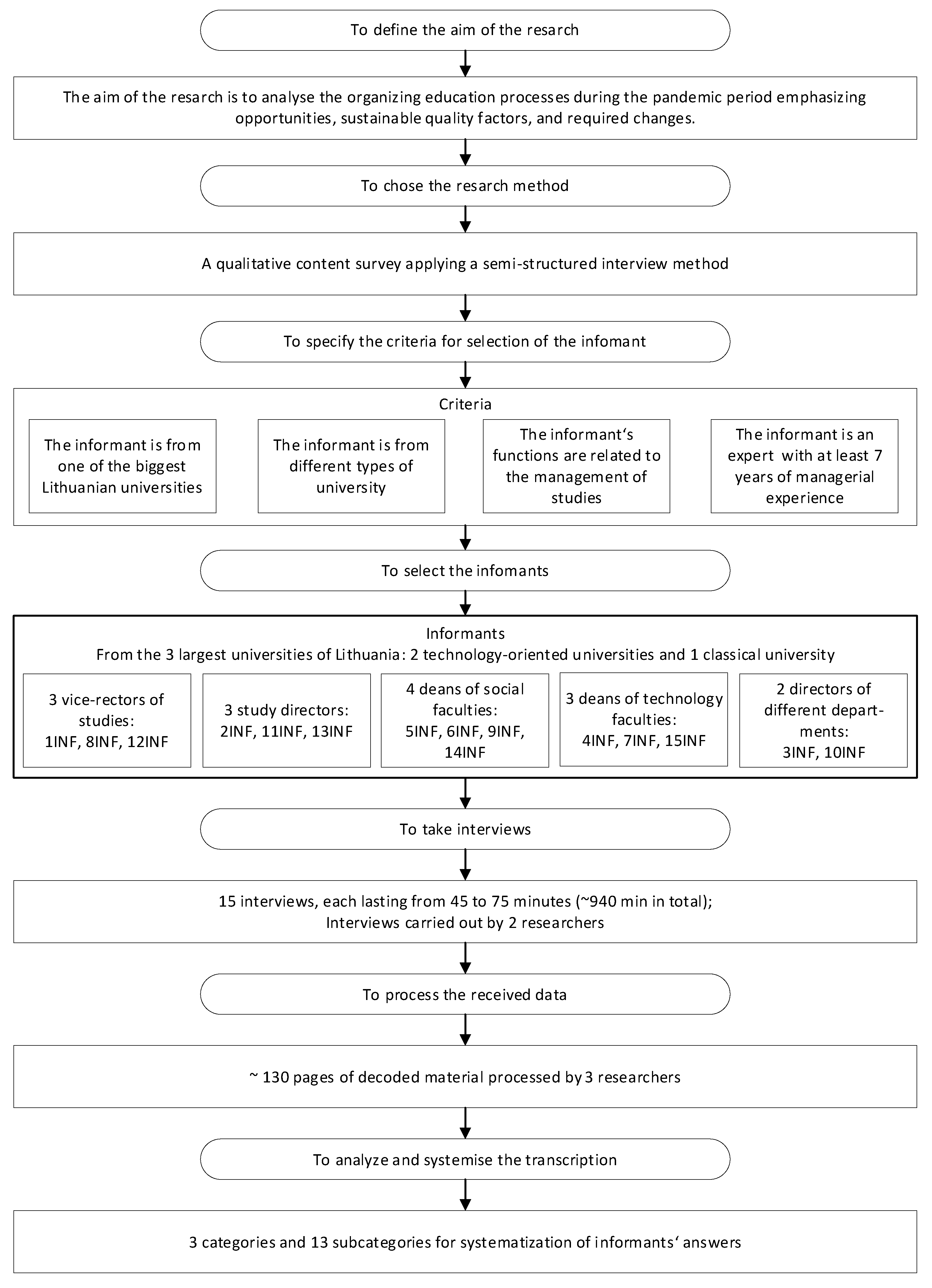
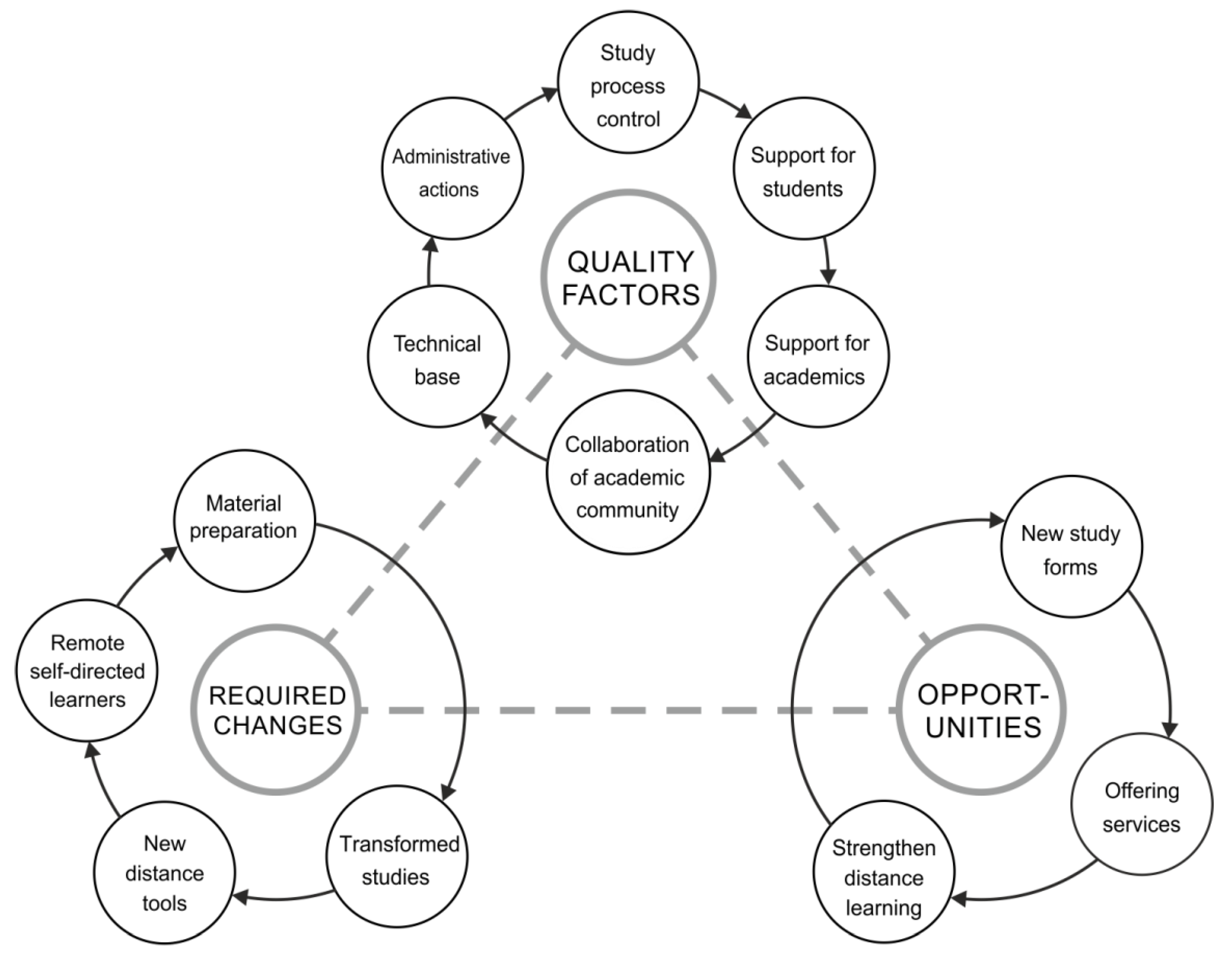
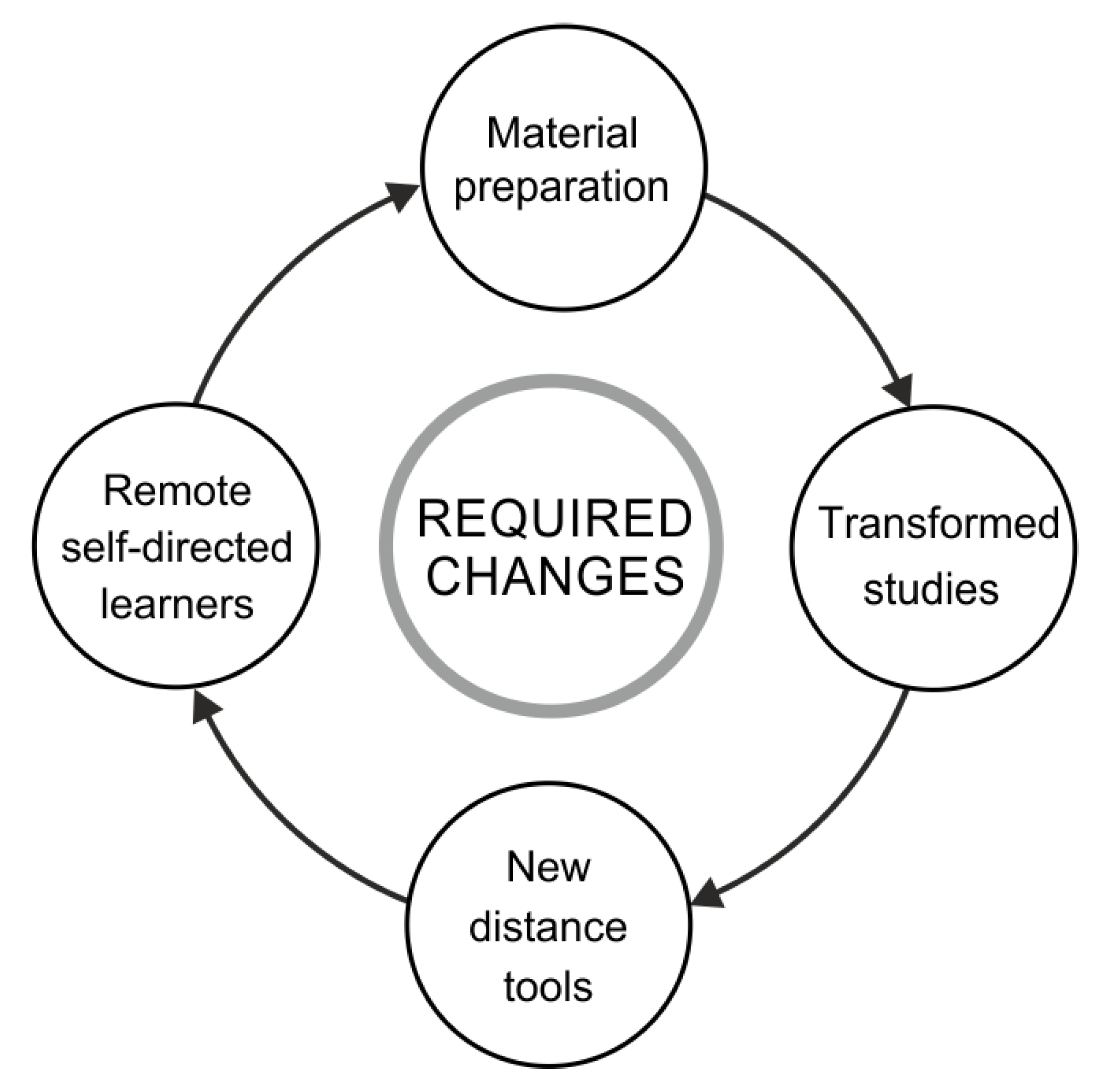
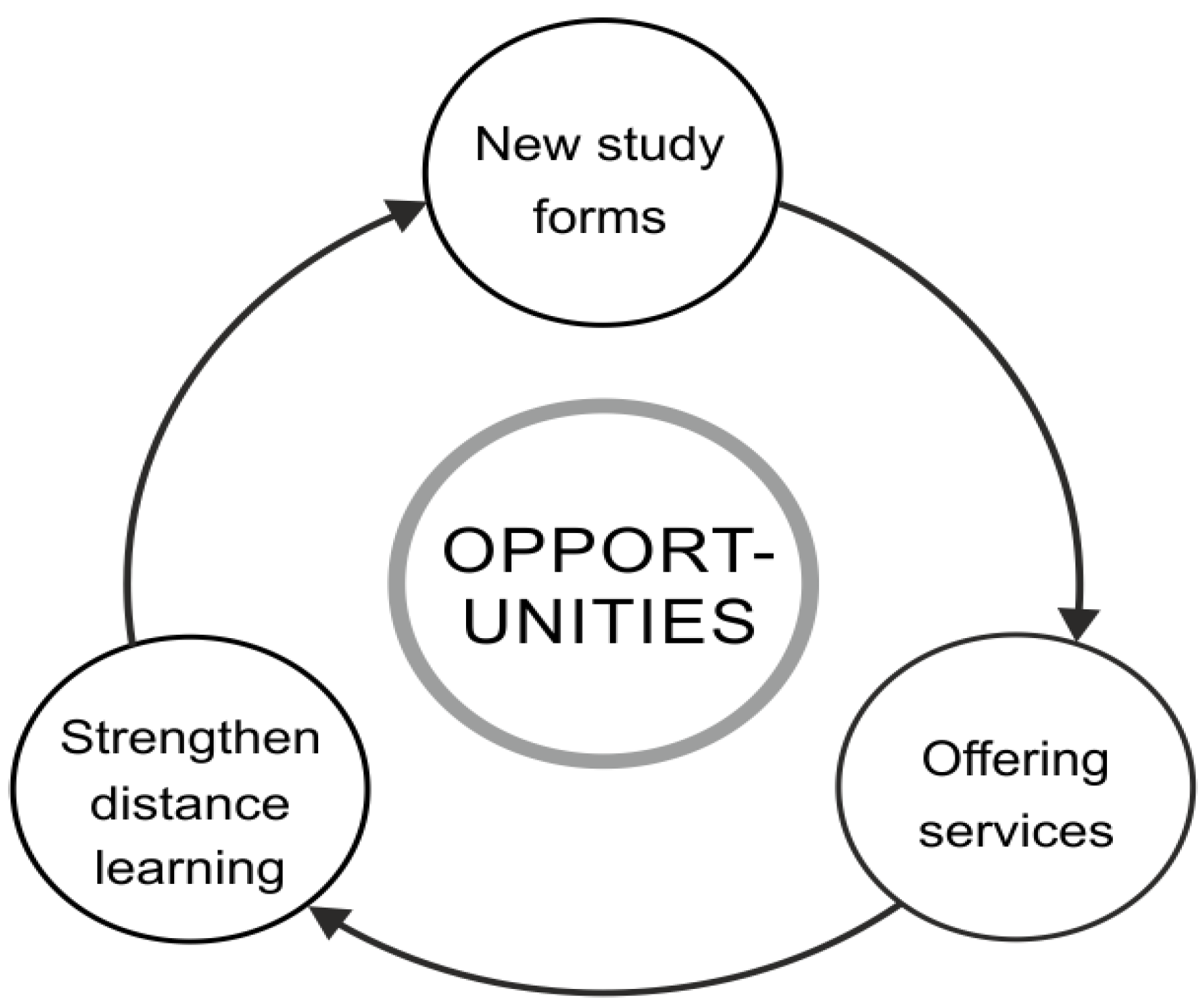
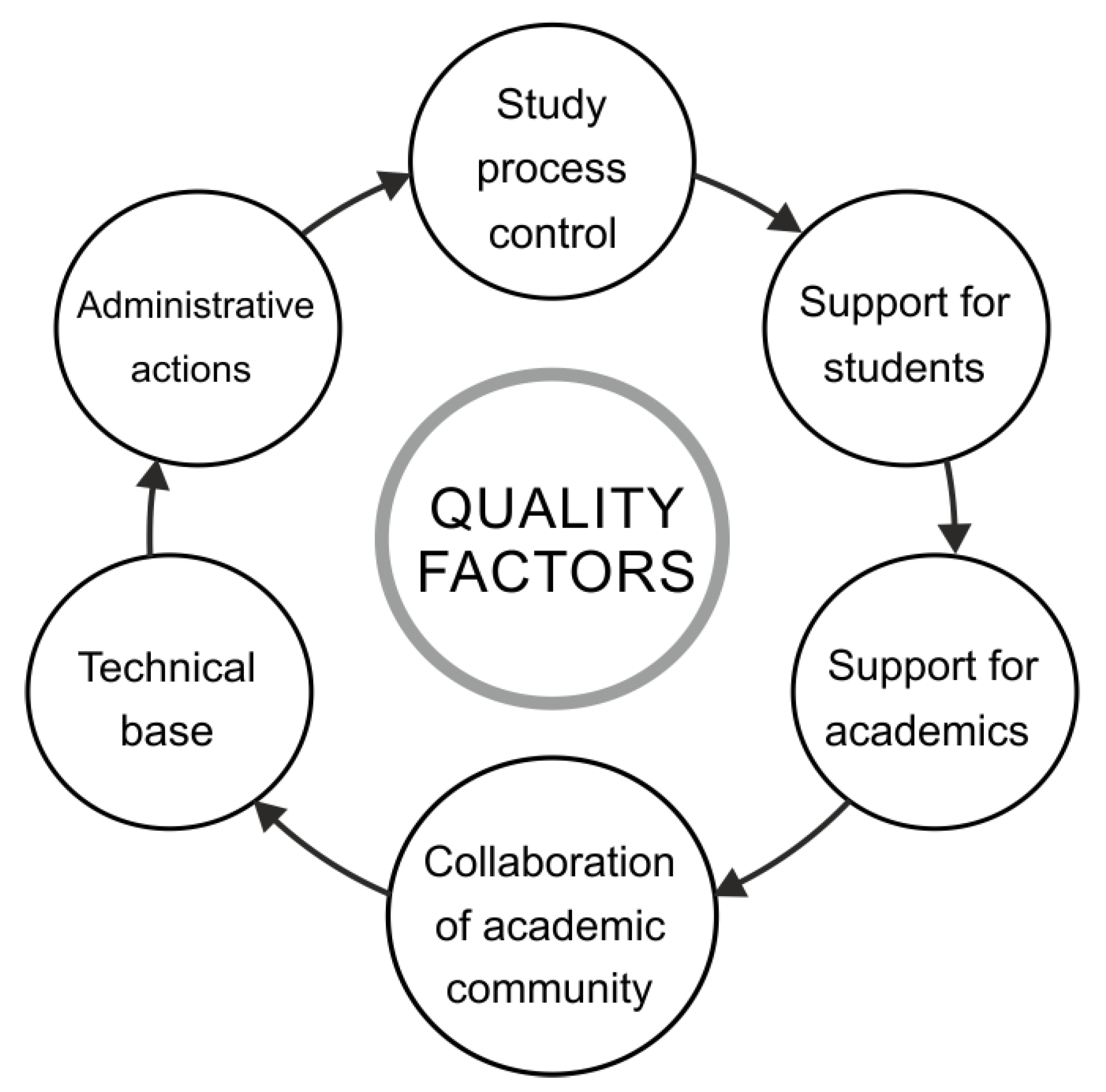
Publisher’s Note: MDPI stays neutral with regard to jurisdictional claims in published maps and institutional affiliations. |
© 2022 by the authors. Licensee MDPI, Basel, Switzerland. This article is an open access article distributed under the terms and conditions of the Creative Commons Attribution (CC BY) license (https://creativecommons.org/licenses/by/4.0/).
Share and Cite
Dagiene, V.; Jasute, E.; Navickiene, V.; Butkiene, R.; Gudoniene, D. Opportunities, Quality Factors, and Required Changes during the Pandemic Based on Higher Education Leaders’ Perspective. Sustainability 2022, 14, 1933. https://doi.org/10.3390/su14031933
Dagiene V, Jasute E, Navickiene V, Butkiene R, Gudoniene D. Opportunities, Quality Factors, and Required Changes during the Pandemic Based on Higher Education Leaders’ Perspective. Sustainability. 2022; 14(3):1933. https://doi.org/10.3390/su14031933
Chicago/Turabian StyleDagiene, Valentina, Egle Jasute, Vida Navickiene, Rita Butkiene, and Daina Gudoniene. 2022. "Opportunities, Quality Factors, and Required Changes during the Pandemic Based on Higher Education Leaders’ Perspective" Sustainability 14, no. 3: 1933. https://doi.org/10.3390/su14031933
APA StyleDagiene, V., Jasute, E., Navickiene, V., Butkiene, R., & Gudoniene, D. (2022). Opportunities, Quality Factors, and Required Changes during the Pandemic Based on Higher Education Leaders’ Perspective. Sustainability, 14(3), 1933. https://doi.org/10.3390/su14031933







